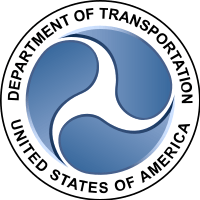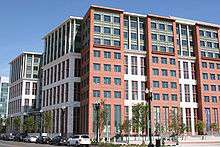United States Department of Transportation
The United States Department of Transportation (USDOT or DOT) is a federal Cabinet department of the U.S. government concerned with transportation. It was established by an act of Congress on October 15, 1966, and began operation on April 1, 1967. It is governed by the United States Secretary of Transportation.
 Seal of the United States Department of Transportation | |
 Flag of the United States Department of Transportation | |
 Headquarters of the U.S. Department of Transportation | |
| Department overview | |
|---|---|
| Formed | April 1, 1967 |
| Jurisdiction | United States of America |
| Headquarters | 1200 New Jersey Avenue SE, Washington, D.C. 38°52′32.92″N 77°0′10.26″W |
| Employees | 58,622 |
| Annual budget | $72.4 billion USD (FY2015, enacted)[1] |
| Department executive | |
| Child agencies |
|
| Website | www |
.svg.png)
.png)
History
Prior to the Department of Transportation, the Under Secretary of Commerce for Transportation administered the functions now associated with the DOT. In 1965, Najeeb Halaby, administrator of the Federal Aviation Agency – the future Federal Aviation Administration (FAA) – suggested to U.S. President Lyndon B. Johnson that transportation be elevated to a cabinet-level post, and that the FAA be folded into the DOT.[2] The idea of having a federal department of transportation was first proposed by former President Woodrow Wilson in 1921-22.[3]
Administrations
- Federal Aviation Administration (FAA)
- Federal Highway Administration (FHWA)
- Federal Motor Carrier Safety Administration (FMCSA)
- Federal Railroad Administration (FRA)
- Federal Transit Administration (FTA)
- Maritime Administration (MARAD)
- National Highway Traffic Safety Administration (NHTSA)
- Office of Inspector General (OIG)
- Office of the Secretary of Transportation (OST)
- Pipeline and Hazardous Materials Safety Administration (PHMSA)
- Saint Lawrence Seaway Development Corporation (SLSDC)
- John A. Volpe National Transportation Systems Center
- Bureau of Transportation Statistics (BTS)
Former Administrations
- Transportation Security Administration – transferred to Department of Homeland Security in 2003
- United States Coast Guard – transferred to Department of Homeland Security in 2003
- Surface Transportation Board (STB) – spun off as an independent federal agency in 2015
Budget
In 2012, the DOT awarded $742.5 million in funds from the American Recovery and Reinvestment Act to 11 transit projects. The awardees include light rail projects. Other projects include both a commuter rail extension and a subway project in New York City, and a bus rapid transit system in Springfield, Oregon. The funds subsidize a heavy rail project in northern Virginia, completing the Washington Metropolitan Area Transit Authority's Metro Silver Line to connect Washington, D.C., and the Washington Dulles International Airport.[4] (DOT had previously agreed to subsidize the Silver Line construction to Reston, Virginia.)[5]
President Barack Obama's budget request for fiscal year 2010 also included $1.83 billion in funding for major transit projects, of which more than $600 million went towards 10 new or expanding transit projects. The budget provided additional funding for all of the projects currently receiving Recovery Act funding, except for the bus rapid transit project. It also continued funding for another 18 transit projects that are either currently under construction or soon will be.[4]
Following the same the Consolidated Appropriations Act of 2014 delegates $600 million for Infrastructure Investments, referred to as Discretionary Grants.
The Department of Transportation was authorized a budget for Fiscal Year 2016 of $75.1 billion. The budget authorization is broken down as follows:[6]
| Administration | Funding (in millions) | Employees (FTE) |
|---|---|---|
| Federal Aviation Administration | $16,280.7 | 45,988 |
| Federal Highway Administration | $43,049.7 | 2,782 |
| Federal Motor Carrier Safety Administration | $580.4 | 1,175 |
| National Highway Traffic Safety Administration | $869.0 | 639 |
| Federal Transit Administration | $11,782.6 | 585 |
| Federal Railroad Administration | $1,699.2 | 934 |
| Pipelines and Hazardous Materials Safety Administration | $249.6 | 575 |
| Maritime Administration | $399.3 | 835 |
| Saint Lawrence Seaway Development Corporation | $28.4 | 144 |
| Office of the Secretary | $935.4 | 1,284 |
| Office of the Inspector General | $87.5 | 413 |
| TOTAL | $75,536.1 | 55,739 |
Related legislation
- 1806 – Cumberland Road
- 1862 – Pacific Railway Act[7]
- 1887 – Interstate Commerce Act
- 1916 – Adamson Railway Labor Act
- 1935 – Motor Carrier Act
- 1946 – Federal Airport Act PL 79-377
- 1950 – Federal Aid to Highway PL 81-769
- 1954 – Saint Lawrence Seaway Act
- 1956 – Federal-Aid to Highway/Interstate Highway Act PL 84-627
- 1957 – Airways Modernization Act PL 85-133
- 1958 – Transportation Act of 1958 PL 85-625
- 1958 – Federal Aviation Act PL 85-726
- 1959 – Airport Construction Act PL 86-72
- 1964 – Urban Mass Transportation Act PL 88-365
- 1965 – Highway Beautification Act PL 89-285
- 1966 – Department of Transportation established PL 89-670
- 1970 – Urban Mass Transportation Act PL 91-453
- 1970 – Rail Passenger Service Act PL 91-518
- 1970 – Airport and Airway Development Act PL 91-258
- 1973 – Federal Aid Highway Act PL 93-87
- 1973 – Amtrak Improvement Act PL 93-146
- 1973 – Federal Aid Highway Act PL 93-87
- 1974 – National Mass Transportation Assistance Act PL 93-503
- 1976 – Railroad Revitalization and Regulatory Reform Act PL 94-210
- 1976 – Hart-Scott-Rodino Antitrust Improvements Act PL 94-435
- 1978 – Airline Deregulation Act PL 95-504
- 1980 – Motor Carrier Act PL 96-296
- 1980 – Staggers Rail Act PL 96-448
- 1982 – Transportation Assistance Act PL 97-424
- 1982 – Bus Regulatory Reform Act PL 97-261
- 1987 – Surface Transportation Act PL 100-17
- 1991 – Intermodal Surface Transportation Efficiency Act PL 102-240
- 1998 – Transportation Equity Act for the 21st Century PL 105-178
- 2000 – Wendell H. Ford Aviation Investment and Reform Act for the 21st Century PL 106-181
- 2001 – Aviation and Transportation Security Act (PL 107-71)
- 2002 – Homeland Security Act (PL 107-296)
- 2005 – Safe, Accountable, Flexible, Efficient Transportation Equity Act: A Legacy for Users (PL 109-59)
- 2012 – Moving Ahead for Progress in the 21st Century Act (MAP-21) PL 112-141
- 2015 – Fixing America's Surface Transportation Act (FAST Act) PL 114-94
Freedom of Information Act processing performance
In the latest Center for Effective Government analysis of 15 federal agencies which receive the most Freedom of Information Act FOIA requests, published in 2015 (using 2012 and 2013 data, the most recent years available), the Department of Transportation earned a D by scoring 65 out of a possible 100 points, i.e. did not earn a satisfactory overall grade.[8]
See also
- Title 23 of the Code of Federal Regulations
- American Highway Users Alliance
- National Highway System (United States)
- National Transportation Safety Board
- Passenger vehicles in the United States
- Transportation in the United States
- United States Federal Maritime Commission
- Turner-Fairbank Highway Research Center
Notes and references
- FY 2017 Department of Transportation Budget Request Archived April 29, 2017, at the Wayback Machine, pg 7, United States Department of Transportation, Accessed October 25, 2017
- "US Department of Transportation, History". National Transportation Library. March 1, 2009. Archived from the original on October 25, 2012.
- Ware, Susan; Berg, Scott (December 2003). "The Hepburn Enigma". The Women's Review of Books. 21 (3): 20. doi:10.2307/4024203. ISSN 0738-1433.
- "DOT Awards $742.5 Million in Recovery Act Funds to 11 Transit Projects". EERE Network News. May 13, 2009. Archived from the original on May 28, 2010. Retrieved August 9, 2010.
- "Annual Report on Funding Recommendations – Fiscal Year 2010" (PDF). U.S. Department of Transportation. April 29, 2009. pp. A-75 (101) & seq. Archived (PDF) from the original on May 28, 2010. Retrieved August 9, 2010.
- "Archived copy" (PDF). Archived (PDF) from the original on April 29, 2017. Retrieved March 29, 2017.CS1 maint: archived copy as title (link)
- "Profile Showing the Grades upon the Different Routes Surveyed for the Union Pacific Rail Road Between the Missouri River and the Valley of the Platte River". World Digital Library. 1865. Archived from the original on November 2, 2013. Retrieved July 16, 2013.
- Making the Grade: Access to Information Scorecard 2015 Archived March 13, 2016, at the Wayback Machine March 2015, 80 pages, Center for Effective Government, retrieved March 21, 2016
External links
| Wikimedia Commons has media related to United States Department of Transportation. |
- Official website

- Department of Transportation on USAspending.gov
- United States Department of Transportation in the Federal Register
![]()